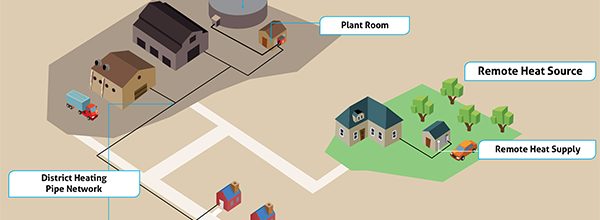At Mibec we pride ourselves on being at the foremost of District Heating solutions and have a great range of products available to enable the customer to assemble systems to meet their needs. In this short article we investigate the key components of a District Heating network.
District heating overview
First of all, what is a District Heating scheme? Simply put it is a project where there is a single centralised heat source supplying heating water and / or domestic hot water two or more separate buildings on the site via an underground pipe network. At the heart of the District Heating philosophy is the concept of improving energy efficiency, reducing CO2, dependence on fossil fuels and saving on running costs by having one large heat source running very efficiently, rather than each building having separate smaller ones running less efficiently.
District heating lends itself well to projects such as starter homes, apartments, social housing and holiday parks which would normally require multiple small boilers which can be much less efficient overall. However it’s not just small buildings, District Heating projects can range in scale from a heat source supplying 2 or 3 properties all the way up to city-wide schemes.
The concept is also very popular in geographical areas located off the mains gas grid and therefore making a large renewable heat source a great option, especially when coupled with the Renewable Heat Incentive giving the owner the opportunity to receive annual RHI payments. District Heating is also widely used in agricultural applications where typically there could be a combination of residential properties on the site, perhaps a few small business units, along with farm buildings that need heating for agricultural processes (e.g. drying gain or animal feed etc).
Heat source
The centralised heat source is usually based on a renewable technology such as Biomass or Biogas, Geothermal, or a boiler for wood or pellets. We have range of products here such as German manufactured heat pumps from Waterkotte and biomass boilers from Hargassner, one of the leading European boiler manufacturers.
Buffer tanks
The chosen heat source can then be combined with one of our buffer tanks for example in a central plant room. The buffer tank retains heat for later use with the flexibility of immediate access without the heat source needing to get up to temperature; this can be very useful for maintaining a constant output when the scheme is needing to supply multiple properties all year round and with variable demand.
Pre-insulated pipe
The central heat source (with Buffer tank) will then be connected to the various buildings in the scheme via an underground pipe network. We offer a wide range of pre-insulated pipes to maintain the water temperature when in transit (avoiding heat losses to improve energy efficiency).
Pre-insulated pipes are extremely flexible and lightweight allowing for rapid installation and the ability to easily navigate over or around obstacles (such as trees and existing buildings) on site. Due to the flexibility of the pipe they are supplied in long coils (up to 250 metres) allowing for easy transport, delivery and storage on site. The pipe is also easy to handle; the installers can roll out the pipe straight into the pre-prepared trench directly from the coil (either by hand for smaller sizes or using a de-coiler). The ability to keep the pipe in a single long flexible piece and being able to easily cut to length has many advantages in terms of limiting the number of joints required minimising installation costs. The products offered are high quality, all thermally insulated with double-skinned outer jackets. We can supply underground pre-insulated pipe products from leading district heating pipe manufacturers like Rehau, Microflex or our own Mibec DHP pipe.
Heat interface units
Where the buildings within the district heating scheme are individual properties or dwellings then our range of Heat Interface Units (HIUs) are a perfect solution (also sometimes known as Heat Boxes and Consumer Interface Units). Each property has its own HIU installed, which uses heat distributed from the central network provide a very responsive heating and domestic hot water (DHW) supply – completely replacing the requirement for individual boilers in each property. To the end user it’s just like having a boiler as normal but without the flame.
Occupants will find that all their hot water and heating requirements are easily supplied by HIUs, which provide instant supply on demand. HIUs also take up very little space(our units will fit into a standard 600mm cupboard), and maintenance requirements on an HIU are very straight forward compared to a gas boiler, with easy access to all components inside the box for the service engineer – saving time and money. For example the plate heat exchangers are extremely easy to access and can be removed for cleaning in seconds.
Mibec design service
We offer a full free of charge specification service covering the whole of the UK, designed to support architects, specifiers or contractors, helping you to select the right District Heating solution from various elements described to form a full system to meet your needs. Please feel free to email or call our support department on 01948 661639 where one of our trained advisers will be happy to help you.


